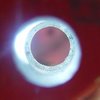Don't use a 550 so I don't know if you have a free station or not.
As Havok7416 said, the Dillon 550 series presses only have four stations.
If you separate the resizing process from the loading process, you can shuffle the powder measure around to free up a station four a powder check die system when loading the cartridges.
Some folks feel this is sacrilege when running a progressive press, "wasting" the benefits of a progressive. Some folks feel it smooths out the process and gives more control and inspection over individual parts of the process.
Or, you can seat and crimp the bullet in station 4 which would free up station 3 for a powder check system. I believe if you are using Dillon dies, a new seating die from one of the other manufacturers would be needed as Dillon seating dies do not crimp.
Either way is not wrong, just the individual preference.
There are advantages and disadvantages for either method that the individual has to consider.





